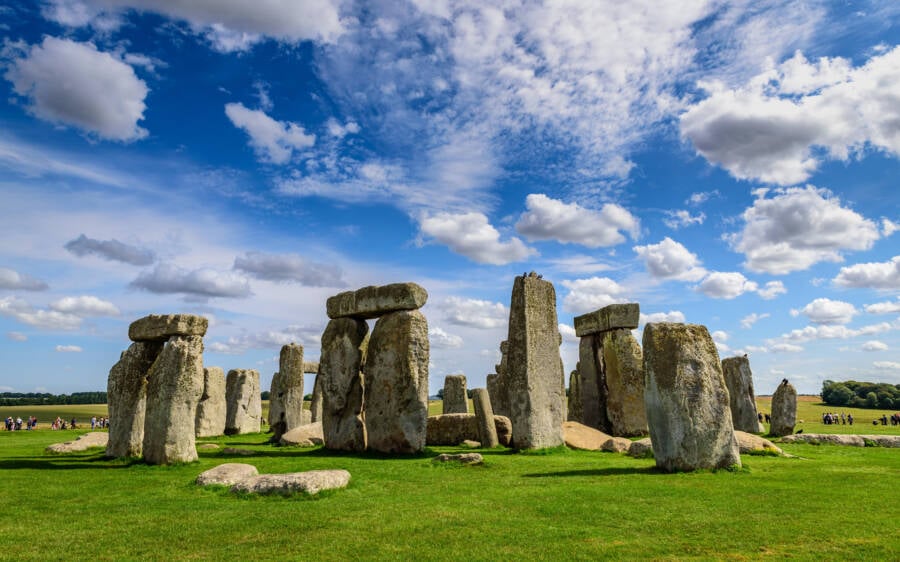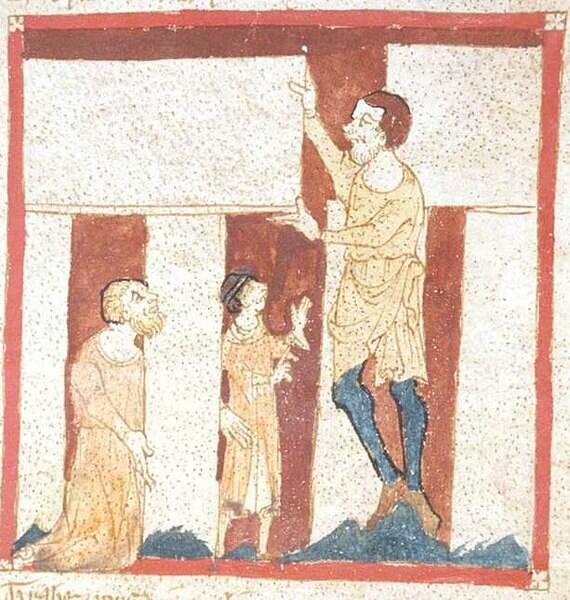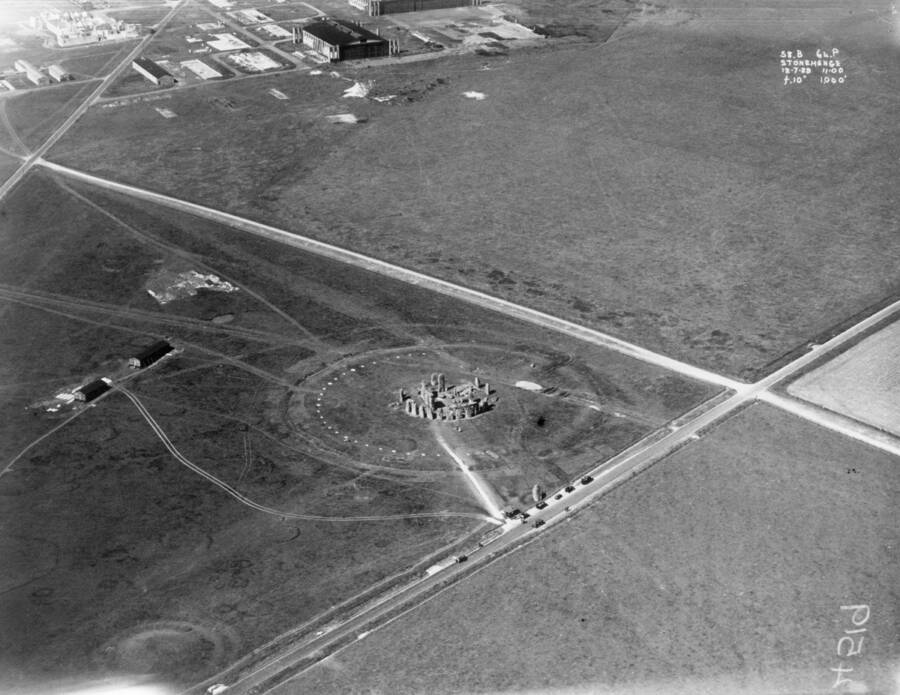The ancient Britons who constructed Stonehenge seemingly did so to track solstices and other solar events, but nobody knows exactly who they were or how they dragged the massive megaliths across the English countryside.

Vic Powles / Alamy Stock PhotoStonehenge, the prehistoric monument in Wiltshire, England.
Stonehenge is one of history’s greatest mysteries. For centuries, experts have excavated and analyzed the site in the English countryside in an effort to decipher its shadowy past. How was the monument erected? What was it used for? And who built Stonehenge?
Theories about who constructed Stonehenge range from Druids to aliens, but most researchers agree that the massive megaliths were likely dragged to Salisbury Plain and raised by Neolithic farmers. The monument may have been used as a solar calendar that let ancient Britons know when to plant and harvest their crops.
To make matters more puzzling, DNA analysis of bodies buried near the site suggests that the builders of Stonehenge had ancestry outside of England. Given that construction of the monument began around 3000 B.C.E., this discovery adds a whole new layer to the mystery of who built Stonehenge.
Unraveling The Shadowy Origins Of Stonehenge
Beginning around 3000 B.C.E., an unknown group of prehistoric people constructed an earthen bank and ditch on Salisbury Plain in modern-day Wiltshire, England. It was likely around this time that the bluestones, the smaller of the rocks that make up the monument, were brought to the site. Analysis has since shown that the bluestones came from Preseli Hills in Wales — more than 150 miles away.
With each stone weighing between two and five tons, experts are unsure exactly how the ancient builders of Stonehenge moved them so far 5,000 years ago. The prevailing theory is that they may have been transported by water before they were dragged over land to Salisbury Plain.
Over the next 1,500 years, other ancient groups continued to add to the monument. According to English Heritage, the larger megaliths, known as sarsen stones, were raised at the site around 2500 B.C.E. Though laborers didn’t have to move the sarsen stones as far — they came from Marlborough Downs, located about 15 miles away — the rocks were much heavier at 25 tons each.
Then, between 2500 and 1500 B.C.E., the megaliths were rearranged into their final formation, which precisely aligned with the movement of the Sun. To this day, they perfectly frame the sunrise on the summer solstice and the sunset on the winter solstice.

Ivan Vdovin / Alamy Stock PhotoStonehenge was likely built by Neolithic farmers — but some theorists believe it was erected by extraterrestrials.
This alignment has led archaeologists to hypothesize that Stonehenge was created partly as a solar calendar. However, other theories suggest the monument was a ceremonial site.
Like any structure this old, the truth about its construction and purpose may never be fully determined. So, for centuries now, people have been putting forth their own ideas about who built Stonehenge — and why.
The Legend Of The Wizard Merlin And Stonehenge
During the Middle Ages, Europeans explained Stonehenge through the lens of fairy tales and legends. One of the most common stories about who constructed Stonehenge involved the mythical wizard Merlin.
In 1130 C.E., English historian Henry of Huntingdon wrote of the monument in his Historia Anglorum, stating, “The second marvel [of Britain] is at Stonehenge, where stones of amazing bigness are raised in manner of gateways, so that gateways appear erected over gateways; nor can anyone find out by what contrivance stones so great have been raised to such a height, or for what reason they have been erected in that place.”
Around the same time, however, cleric and chronicler Geoffrey of Monmouth put forth his own theory about how Stonehenge was built. He wrote that in the 5th century C.E., the Saxons slaughtered hundreds of British nobles, who were buried on Salisbury Plain. King Aurelius Ambrosius wanted to erect a memorial above their bodies, and Merlin suggested that a stone ring that had been built by giants in Ireland would be fitting. The wizard magicked the megaliths to Britain, where they marked the mass grave of the deceased noblemen.

Public DomainA 14th-century illustration of Merlin commanding a giant to build Stonehenge.
Other versions of the story claim that Merlin ordered giants to construct Stonehenge. A 14th-century manuscript by the poet Wace illustrating this event is the earliest known depiction of the monument in history.
It wasn’t until the 17th century that someone put forth the more convincing theory that Druids built Stonehenge.
Were Ancient Druids The Builders Of Stonehenge?
John Aubrey, the first researcher to conduct an academic study on Stonehenge in the 1660s, concluded that Druids — ancient Celts who served as teachers, judges, and priests — built the monument. This theory was supported by 18th-century archaeologist William Stukeley. However, modern scholars now disagree that Druids were responsible for the construction of Stonehenge, given the historical timeline.

sandyraidy/Wikimedia CommonsModern Druids at Stonehenge in 2007.
“Druids only emerge in the last half of the first millennium B.C.E,” Caroline Malone, a professor of prehistory at Queen’s University Belfast, told Live Science in 2022. “No druidic evidence has ever been identified at Stonehenge, where instead, we have complex calendrical rituals associated with solstices, death, rebirth, and community events. The Druids did not apparently worship the Sun or solstice, and none of the Iron Age ritual sites suggest such activity or ritual.”
What’s more, the monument predates the Druids by some 2,000 years. Despite this discrepancy, many still believe that the Druids were the people who built Stonehenge. Even today, modern Druids hold festivals at Stonehenge to celebrate the solstices and other celestial events.
“The reason why Druids are associated with Stonehenge is that they are the pagan priesthood of Britain when [written records appear],” Ronald Hutton, a history professor at the University of Bristol, told Live Science. “[W]hen it was realised that the monument was built by the prehistoric British, in the 18th century, it was assumed that the Druids were responsible for it.”
“Only in the 1960s did the public become generally aware, after further advances in archaeology, that it had been built two and a half thousand years before the time at which the Druids are recorded in ancient sources,” Hutton continued.
Some scholars believe that Aubrey, Stukeley, and others included a reference to Druids in their studies of Stonehenge to make their work more interesting for the public — thus creating a myth that many still believe today.
Extraterrestrial Theories About Who Built Stonehenge
Perhaps the most unique theory about Stonehenge is that extraterrestrial beings played a role in its construction.
In 2018, researchers from the Natural History Museum in England conducted a DNA study on remains from the “Beaker people,” ancient Britons known for their unique pottery. They arrived in England from mainland Europe around 2500 B.C.E.
The study found that the genetics of the local Neolithic people who built Stonehenge were almost completely removed from this population. Some observers took this to mean that the builders of Stonehenge simply disappeared over 4,500 years ago.

Royal Air ForceSome theories suggest that Stonehenge is a landing zone for UFOs.
The television show Ancient Aliens explored the possibility of Stonehenge being an “otherworldly portal” that the original builders could have fallen into. Other theories claim that Stonehenge was a map of the solar system based on information given to prehistoric Europeans by aliens. Some people also believe that Stonehenge serves as a landing pad for UFOs or an observatory for extraterrestrial activity.
While the public continues to craft intricate and unique theories about who built Stonehenge, researchers will keep studying the iconic landmark for greater insights into our ancient history.
After learning about the theories of who built Stonehenge, dive into the stories of nine of the oldest structures in the world. Then, read about Coral Castle, the Stonehenge-like structure in Florida built by a single man.





